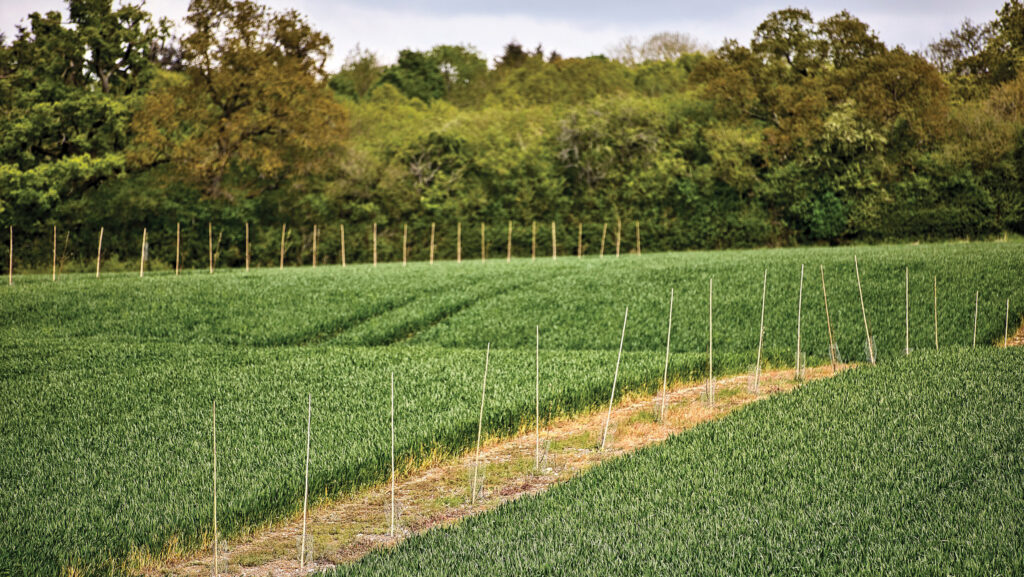How trees can enhance and support your farm business
 © Richard Stanton
© Richard Stanton Woodland and forestry experts urged growers at a recent Transition webinar, to look again at the potential benefits of strategic tree planting.
Transition Project editor and webinar host Johann Tasker was joined by four experts to discuss “Tree planting: everything you need to know”.
They looked at the potential benefits of tree planting, management issues and funding options.
See also: All of our Transition webinars in one place
Woodland, forestry and agroforestry roles and benefits
Some of the benefits mentioned by the panel include:
- Climate resilience Wind barrier, shelter, shade and erosion reduction
- Environment Water filtration, nutrient and carbon retention
- Soil improvement Nutrient supply and retention, water retention and drainage
- Production Timber, fence posts, biomass, tree fruits and nuts
- Recreational Walks, glamping and sport
- Education Forest schools and trails
- Trading Carbon credits and biodiversity net gain units
- Fodder Livestock browsing
Producers have traditionally seen tree planting only as a long-term investment in timber production, said Stephen Briggs.
Instead, it should be viewed as a way of building financial and physical resilience into an agricultural business.
Trees can help protect a farm from climate change shocks in weather extremes, said Denise Walton.
They can act as a physical barrier to wind, or by slowing water flows to limit flooding, erosion or drought.
On arable and pasture systems, trees help soil structure and nutrient profiles. Livestock can also perform better where there is shade and wind protection, she added.
Laura Henderson said woodland offers scope for public activities beyond traditional uses such as shooting.
Woodland glamping, forest schools and learning trails are becoming more popular and represented opportunities.
Strategic objectives for ventures
Emma Bird said it was vital to set out what you are trying to achieve, whether it is timber production, a carbon scheme, educational or an environmental or productivity target.
“Planning, along with a consultant or adviser, will help to ensure you plant the right tree in the right place and access the support available.
“The process must also look at the specific challenges on your farm, whether that is local climate or threats from the key pests – deer and squirrels.
“If you’re considering fruit or nut tree varieties, look at the potential in local markets and consider how you might harvest the produce.”
Ms Henderson encouraged setting targets that yielded benefits across the business.
For example, consider whether there are less productive areas, such as field corners, that could yield an income or where improvements to soil structure can be made with in-field trees.
Charlie Elliot emphasised the importance of tree variety selection.
A diversity of plants was always best to meet multiple objectives, and he pointed out that growers were only permitted to grow 65% of one species under the UK Forest Standard.
Another constraint was the new England Woodland Creation Offer, which states that only 20% of trees planted can be non-native if growers are applying to get the higher level nature recovery payment, he said.
In Scotland, Ms Walton said that the Scottish Forestry’s Woodland Creation grant scheme would determine what species could be grown to ensure they were compatible with the area.
Funding support
Mr Elliot said it was vital to establish what funding support was available because it helped de-risk the early capital investment.
Ms Walton added that the long delay in returns made early stage grant funding essential for planting and maintaining tree ventures.
She had collaborated with neighbouring farms on a bid to Nature Scot’s Nature Restoration Fund.
It enabled landowners to plant 11km of trees over two years, to act as a windbreak and protect livestock and wildlife.
Income streams and funding schemes can also be stacked, said Mr Briggs.
This makes tree planting more attractive with income streams from education, biodiversity, carbon offsetting, and tree products all possible.
Agroforestry planting on his farm, using small fruiting trees, had seen a return of investment in just seven and a half years, with wider benefits from soil and water management achieved.
Those considering carbon selling ventures, must register on the Woodland Carbon Code before any work begins, stressed Ms Bird.
The experts
- Emma Bird, agroforestry project manager, Woodland Trust
- Stephen Briggs, farmer and director, Abacas Agri farm business consultancy
- Charlie Elliot, sales and development manager, Tilhill Forestry
- Laura Henderson, director, English Woodlands Forestry consultancy
- Denise Walton, Scottish chairman for the Nature Friendly Farming Network
